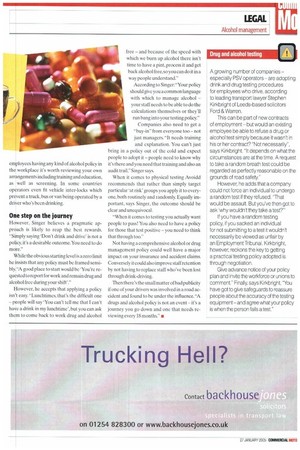Ready to run the risk?
Page 34

Page 35

If you've noticed an error in this article please click here to report it so we can fix it.
'Risk management" is rapidly becoming a mantra for senior managers. n the second of two reports Brian Weatherley looks at how Dperators should tackle drink and drugs abuse within the workforce.
INhen no lesser person than TUC general secretary Brendan Barber declares "drink is definitely a vorkplace issue" we'd all better sit up and ake notice.
Indeed, any company which allows an emrloyee to drive a commercial vehicle while [rider the influence of ■ roper risk management ■ rogramme. That was just me of the more uncomortable messages coming ■ ut of the recent confernce Managing Occupaonal Road Risk.
But how would you :now whether an HGV [river, forklift operator or ffice worker was under he influence of either? Screening for drugs and .1cohol in the workforce e ems an obvious answer • but as Roger Singer, nanaging director of Woidd, it has to be more han a knee-jerk reaction. Zeading-based Avoidd opvides drugs and alcohol ecognition training for nanagers along with [rink-drive avoidance Ldvice and on-site testing According to Singer: "Drink drivers are always seen as them,not us." Yet statistics show offenders are frighteningly "normal" coming from all walks of life and occupations and typically consuming 36 units of alcohol a week compared with the average of 28. "Most are in work and drive for a living — though not any more", notes Singer, adding that those convicted of drink driving are normally caught after being followed by the police and stopped, rather than being involved in a road accident.
"Some clearly know they're over the limit and are determined to drink and drive," he says. "However, there's an enormous number who simply don't know they're over the limit."
The major worry for hauliers is when a HGV driver employee follows a heavy night's drinking with the traditionally "early start" and is still over the limit the next day (see panel)."Some 17% of all drink drive convictions are 'morning afters' with many people not even realising they are over the limit,"says Singer.
Significantly, one of the tell-tale signs of alcohol abuse is the number of workers who call in with Monday morning sickness. "What customers tell us is when they've been doing drink-drive awareness, and general alcohol and drugs knowledge, their Monday morning`sickies' drop off," reports Singer.
With only half of all UK employees having any kind of alcohol policy in the workplace it's worth reviewing your own aiTangements including training and education, as well as screening. In some countries operators even fit vehicle inter-locks which prevent a truck, bus or van being operated by a driver who's been drinking.
One step on the journey
However, Singer believes a pragmatic approach is likely to reap the best rewards. "Simply saying 'Don't drink and drive' is not a policy, it's a desirable outcome. You need to do more."
While the obvious starting level is a zero limit he insists that any policy must be framed sensibly."A good place to start would be 'You're requested to report for work and remain drug and alcohol free during your shift'."
However, he accepts that applying a policy isn't easy. "Lunchtimes, that's the difficult one people ill say 'You can't tell me that I can't have a drink in my lunchtime', but you can ask them to come back to work drug and alcohol free and because of the speed with which we burn up alcohol there isn't time to have a pint, process it and get back alcohol free, so you can do it in a way people understand."
According to Singer:"Your policy should give you a common language with which to manage alcohol your staff needs to be able to do the calculations themselves or they'll run bang into your testing policy."
Companies also need to get a "buy-in" from everyone too not just managers. "It needs training and explanation. You can't just bring in a policy out of the cold and expect people to adopt it people need to know why it's there and you need that training and also an audit trail," Singer says.
When it comes to physical testing Avoidd recommends that rather than simply target particular at risk' groups you apply it to everyone, both routinely and randomly. Equally important, says Singer, the outcome should be clear and unequivocal.
"When it comes to testing you actually want people to pass! You also need to have a policy for those that test positive you need to think that through too."
Not having a comprehensive alcohol or drug management policy could well have a major impact on your insurance and accident claims. Conversely it could also improve staff retention by not having to replace staff who've been lost through drink-driving.
Then there's the small matter of bad publicity if one of your drivers was involved in a road accident and found to be under the influence. -A drugs and alcohol policy is not an event it's a journey you go down and one that needs reviewing every 18 months." •


































































































































































































